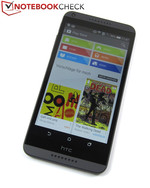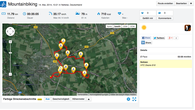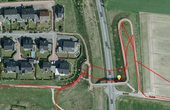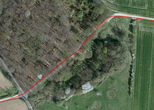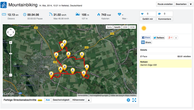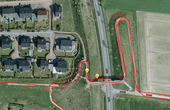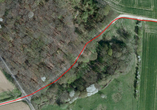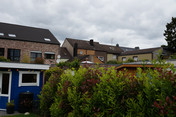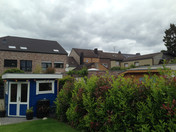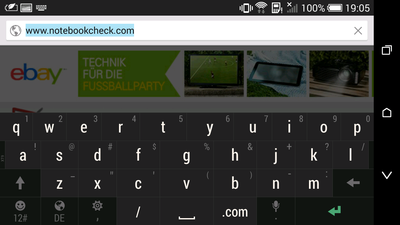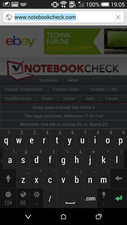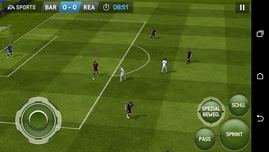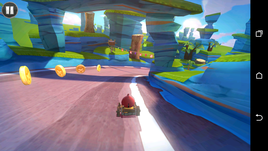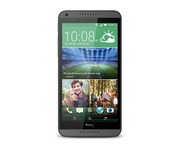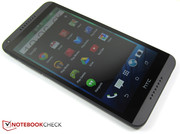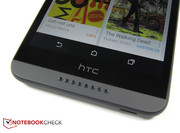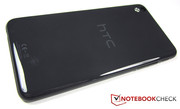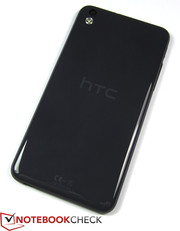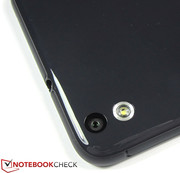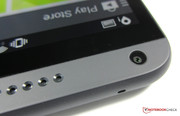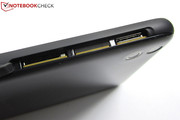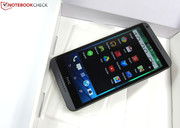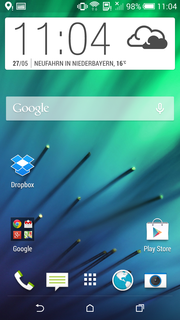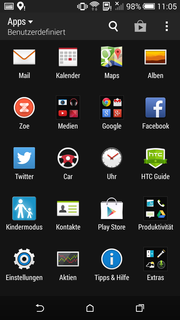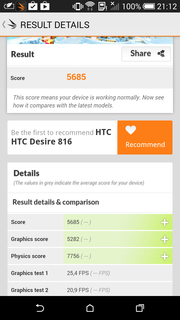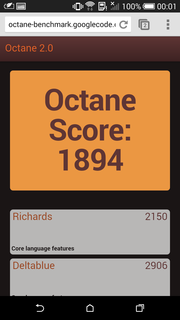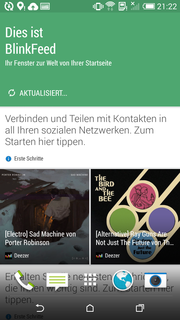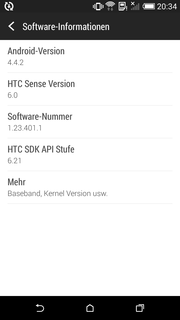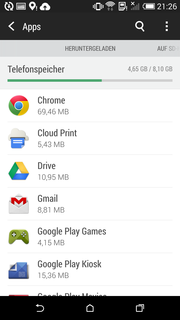HTC Desire 816 Smartphone Review

For the original German review, see here.
HTC offers the Desire 816 as a middle-class smartphone for 379 Euros (~$516). Our HTC test model packs a lot more features than one would expect in a middle-class smartphone. In fact, the Desire 816 is equipped as well as most top-tier smartphones.
The list of incentives to purchase this model is long indeed: It starts with a 5.5-inch screen with a resolution of 1280x720 pixels and ends with a 13 MP main camera and a 5 MP front camera. Additionally, the smartphone uses a Qualcomm Snapdragon 400 MSM8928, which is a powerful quad-core SoC, with 1.5 GB RAM and an integrated Qualcomm Adreno 305 IGP. The highlight of the HTC must be its fast LTE module, and it does not hurt that the device runs on the latest Android OS (version 4.4.2).
Case
No metal case is to be found in the HTC Desire 816, as instead the manufacturer has chosen synthetic material for every inch of chassis. This does not mean that the device looks cheap or feels fragile: To the contrary, the HTC model (available in white, blue and gray) has great workmanship and is very sturdy. Despite measuring a mere 7.9 mm in thickness and weighing 165 grams, this smartphone managed to withstand all our efforts to deform or bend its surfaces. The smooth back is a matter of taste and can pose a hazard as it offers a poor grip. Furthermore, it quickly accumulates smudges.
Most 5.5-inch smartphones with similar SoC performance are not as slim as our test model. The thickness and weight of the Desire 816 is similar to that of the Samsung Galaxy Note 3 Neo N7505, which measures 8.1 mm thick and weighs 162 grams. Other 5.5-inch devices like the Huawei Ascend G730 are much thicker and heavier (9.6 mm, 187 grams).
Connectivity
HTC uses a quad-core SoC (System-on-a-Chip), dubbed the Qualcomm Snapdragon 400 MSM8928. Its 4 cores operate at 1.6 GHz each and are accompanied by the Qualcomm Adreno 305 IGP (Integrated Graphics Processor) with 1.5 GB RAM and 8 GB storage. However, those who are familiar with Android will be acutely familiar with how fast apps can gobble up the free space. The situation is exacerbated by HTC preinstalling apps on the smartphone, and thus leaving a mere 4.6 GB free for the user from the get-go. The microSD slot allows the memory to be extended by up to 128 GB.
Software
The Desire 816 runs Android 4.4.2 (KitKat). The UI (User Interface) employs the well-known HTC Sense overlay (latest version: 6.0). A highlight of HTC Sense is its "Blinkfeed" which bundles together news and notifications from social services for the user. HTC has installed a lot of apps on the Desire 816: ranging from various Google apps, like Chrome, Gmail, Google+ and Maps, to Facebook, Twitter and HTC's own creations, like the HTC Guide.
Communication & GPS
The HTC Desire 816 is well-equipped in this department: The smartphone can handle the GSM quad-band, UMTS tri-band and the LTE standard. Local data transfer is possible via WLAN 802.11 b/g/n or Bluetooth 4.0 with aptX support. During our tests, we did not note any interruptions/drops in the signal quality.
The GPS antenna of the Desire 816 can quickly and reliably locate the device, as long as the user is relatively motionless (in a building or outdoors). When we took the model for a driving test, the GPS position was often off the road during our 12-km bike ride. The smartphone copes well with heavily wooded areas, but in narrow passages it is far less accurate than the professional navigation device, Garmin Edge 500.
Telephone and Speech Quality
A nano-SIM card is used in our model. When calling, the model performs reliably and the person on the other end of the line can hear us clearly. The signal quality is often high, and there were no distortions during our test.
Cameras & Multimedia
The HTC Desire 816 produces useable pictures with its cameras. The front webcam is an impressive 5 MP (max 2560x1440 pixels), and the main camera on the back offers 13 MP (up to 4224x2368 pixels in the 16:9 format). Both support video recordings in the Full HD format.
The cameras are definitely satisfactory. One should not zoom into a picture too much, as it quickly becomes clear that the sharpness, contrast and dynamics are poor. Indoor pictures come out quite blurred. Compared to good cameras, from models like the Apple iPhone 5 or the Nokia 1020, the Desire 816 is severely lacking.
Accessories & Warranty
The packaging of the HTC Desire 816 should include a micro-USB cable, headphones and a proprietary USB adapter. Our test model was delivered without these, which is an exception, and thus will not affect the overall rating.
On the HTC homepage, the manufacturer offers many accessories for its new model. This includes an external battery and a smartphone remote, the HTC Mini+. The Desire 816 has 24-months warranty.
Input Devices & Interface
The 5.5-inch touchscreen of the HTC Desire 816 reacts quickly and precisely to input and can recognize up to 10 fingers simultaneously. Thanks to the quad-core processor, the model suffers no lags when starting apps or the menu. The soft-touch keys and the physical buttons are good and respond well to input. The virtual QWERTY keyboard is a pleasure for typists thanks to its large keys in landscape mode.
Display
The display of the HTC Desire 816 has a resolution of 1280x720 pixels. Full HD is not available for this price, but the colors and contrast are quite strong. The 5.5-inch Samsung Galaxy Note 3 Neo N7505 and the 6-inch Nokia Lumia 1320 use the same resolution.
The display of the test model is great: a brightness of 422.8 cd/m², a black value of 0.55 cd/m² and a contrast ratio of 784:1. At an illumination of 87%, the panel brightness is well-balanced.
The Huawei Ascend G730 (521.7 cd/m²) and the Nokia Lumia 1320 (449.7 cd/m²) are brighter than our test model but cannot compete in terms of black value and contrast ratio.
| |||||||||||||||||||||||||
Brightness Distribution: 87 %
Center on Battery: 431 cd/m²
Contrast: 784:1 (Black: 0.55 cd/m²)
ΔE ColorChecker Calman: 5.66 | ∀{0.5-29.43 Ø4.79}
ΔE Greyscale Calman: 4.23 | ∀{0.09-98 Ø5}
Gamma: 2.31
CCT: 7120 K
Colors and contrast are displayed (subjectively) just fine, but according to our tools, there is a discrepancy. The colorimeter and CalMAN software show us that in the sRGB color spectrum, our red is very pale and our blue is a little too strong. Still, the DeltaE value of 5.66 is close enough to the optimal values. The deviations are smaller when we look at the gray levels (DeltaE of 4.23).
Performance
The quad-core SoC Qualcomm Snapdragon 400 MSM8928 and the Qualcomm Adreno 305 IGP can process all tasks quickly in the HTC Desire 816.
In synthetic benchmarks, the smartphone is just as fast as the LG L90 and the Motorola Moto G, as both use a Qualcomm Snapdragon 400 MSM8926. However, the three models do not stand a chance against the Mali-T624 SoC of the Samsung Galaxy Note 3 Neo N7505. This becomes abundantly clear in the 3DMark and Geekbench 3 benchmarks in which the Samsung model takes a large lead.
| 3DMark - 1280x720 Ice Storm Standard Score (sort by value) | |
| HTC Desire 816 | |
| Huawei Ascend G730 | |
| LG L90 | |
| Motorola Moto G 1. Gen XT1032 | |
| Samsung Galaxy Note 3 Neo N7505 | |
| Epic Citadel - High Quality (sort by value) | |
| HTC Desire 816 | |
| Huawei Ascend G730 | |
| LG L90 | |
| Motorola Moto G 1. Gen XT1032 | |
| Samsung Galaxy Note 3 Neo N7505 | |
| Geekbench 3 | |
| 32 Bit Single-Core Score (sort by value) | |
| HTC Desire 816 | |
| Huawei Ascend G730 | |
| LG L90 | |
| Motorola Moto G 1. Gen XT1032 | |
| Samsung Galaxy Note 3 Neo N7505 | |
| 32 Bit Multi-Core Score (sort by value) | |
| HTC Desire 816 | |
| Huawei Ascend G730 | |
| LG L90 | |
| Motorola Moto G 1. Gen XT1032 | |
| Samsung Galaxy Note 3 Neo N7505 | |
The browser benchmarks once again place the HTC Desire 816 as one of the fastest devices: on par with the LG L90 and the Motorola Moto G. The test model loses its duel with the Samsung Galaxy Note 3 Neo N7505 again.
| Octane V2 - Total Score (sort by value) | |
| HTC Desire 816 | |
| Huawei Ascend G730 | |
| LG L90 | |
| Nokia Lumia 1320 | |
| Samsung Galaxy Note 3 Neo N7505 | |
| Peacekeeper - --- (sort by value) | |
| HTC Desire 816 | |
| Huawei Ascend G730 | |
| LG L90 | |
| Motorola Moto G 1. Gen XT1032 | |
| Nokia Lumia 1320 | |
| Samsung Galaxy Note 3 Neo N7505 | |
| WebXPRT 2013 - Overall (sort by value) | |
| HTC Desire 816 | |
| Huawei Ascend G730 | |
| Motorola Moto G 1. Gen XT1032 | |
| Nokia Lumia 1320 | |
| Samsung Galaxy Note 3 Neo N7505 | |
| Sunspider - 1.0 Total Score (sort by value) | |
| HTC Desire 816 | |
| Huawei Ascend G730 | |
| LG L90 | |
| Motorola Moto G 1. Gen XT1032 | |
| Nokia Lumia 1320 | |
| Samsung Galaxy Note 3 Neo N7505 | |
* ... smaller is better
The read and write performance of the Desire 816 is a little lower than that of the LG L90, the Motorola Moto G and the Samsung Galaxy Note 3 Neo N7505. Only the Huawei Ascend G730 lags even further behind.
Games
Emissions
Temperature
The surface temperatures of the HTC Desire 816 are acceptable. While idle, the smartphone heats up to an average of 30.2 °C and stays just as cool as the competition. At load, the temperature in the middle of the device is 34.5 °C (not even lukewarm). Amongst the competitors, the Samsung Galaxy Note 3 Neo N7505 heats up the most and reaches 41.2 °C.
(+) The maximum temperature on the upper side is 34.5 °C / 94 F, compared to the average of 35.2 °C / 95 F, ranging from 21.9 to 247 °C for the class Smartphone.
(+) The bottom heats up to a maximum of 34.5 °C / 94 F, compared to the average of 34 °C / 93 F
(+) In idle usage, the average temperature for the upper side is 27.4 °C / 81 F, compared to the device average of 32.9 °C / 91 F.
Speakers
Both stereo speakers of the HTC Desire 816 are placed on the sides of the model and can produce good sound, especially when the phone is held in landscape mode. The 8 small openings produce a satisfying sound, which is a lot stronger than the competitors, although it lacks bass. Hopefully, the headphones delivered with the Desire 816 will deliver an even better sound.
Energy Management
Power Consumption
The non-removable lithium-polymer battery of the HTC Desire 816 offers a capacity of 2,600 mAh. While idle, the smartphone consumes a max of 2.2 W, which is quite similar to other 5.5-inch models. At load, the smartphone is very conservative: it consumes a mere 3.5 W. In comparison, its competitors, like the Samsung Galaxy Note 3 Neo N7505 (5.9 W) and the Huawei Ascend G730 (6.8 W) consume a lot more.
| Off / Standby | |
| Idle | |
| Load |
|
Key:
min: | |
Battery Life
The low consumption of the HTC Desire 816 means it can definitely offer good runtimes. In our minimum runtime test (max brightness, all wireless modules on), the smartphone depletes after 4 hours and 33 minutes, which is relatively long.
The max runtime test (minimum brightness, activated power-saving, all wireless modules besides WLAN turned off), the HTC performs quite well: 25 hours and 12 minutes. The runtime is beaten by the Motorola Moto G (25 hours and 15 minutes) but only just barely.
The realistic WLAN test (brightness set to 150 cd/m², power-saving on, running a script which loads websites every 40 seconds) requires 11 hours and 26 minutes to deplete the battery of our test model. This means the model can last an entire workday. However, this runtime is not so great when compared with that of the competitors: The Samsung Galaxy Note 3 Neo N7505 (13 hours and 26 minutes), the Motorola Moto G (15 hours and 30 minutes) and the LG L90 (18 hours and 38 minutes) last much longer.
Verdict
If you are looking for a cheap and powerful smartphone, the HTC Desire 816 is a good pick. The street price of 340 Euros (~$463) is not cheap, but for this price, the 5.5-inch smartphone can offer good hardware which can compete with the performance of top-tier models. The display has a resolution of 1280x720 pixels, and the main 13 MP camera takes decent pictures. The Android 4.4.2 OS is on-board and LTE capability allows the smartphone to achieve fast data rates on-the-go. Thanks to the quad-core SoC Qualcomm Snapdragon 400 MSM8928 the Desire 816 runs fluidly and can deal with the latest games and apps without issues.
HTC has cut few corners and the end product is impressive. We deduct points from the Desire 816 for its relatively small storage of 8 GB, but it can be extended by up to 128 GB. The picture quality could have been better, and the battery should have been removable. Overall, HTC delivers a solid package in the form of the Desire 816.




